The Economics and Statistics Division maintains archives of previous publications for accountability purposes, but makes no updates to keep these documents current with the latest data revisions from Statistics Canada. As a result, information in older documents may not be accurate. Please exercise caution when referring to older documents. For the latest information and historical data, please contact the individual listed to the right.
<--- Return to Archive
For additional information relating to this article, please contact:
July 17, 2024HOUSEHOLD INCOME AND CONSUMPTION, Q1 2024 Household Income and Outlay
In addition to compensation of employees, household income also includes net mixed income (generated from unincorporated businesses), property income received (generated as the result of ownership of assets) and current transfers received (generally from government).
Nova Scotians received $14.57 billion in household income in Q1 2024, including $7.89 billion in employee compensation, $1.86 billion in net mixed income, $1.66 billion in property income received and $3.16 in current transfers received.
After paying current transfers (including income taxes) and property income, Nova Scotia disposable income was $9.16 billion in Q1 2024. Including the $3.63 billion value of social transfers in kind received from governments or non-profits in the form of services provided for households, Nova Scotia had adjusted disposable income of $12.79 billion.
The consumption of social transfers in kind matches the value of social transfers received ($3.63 billion), while households spent $9.65 billion on consumer expenditures. The value of household final consumption expenditures and social transfers in kind exceeded adjusted household disposable income, so the difference must be made up out of negative savings, including a reduction of $0.20 billion in household savings and a $0.29 billion change in pension entitlements.
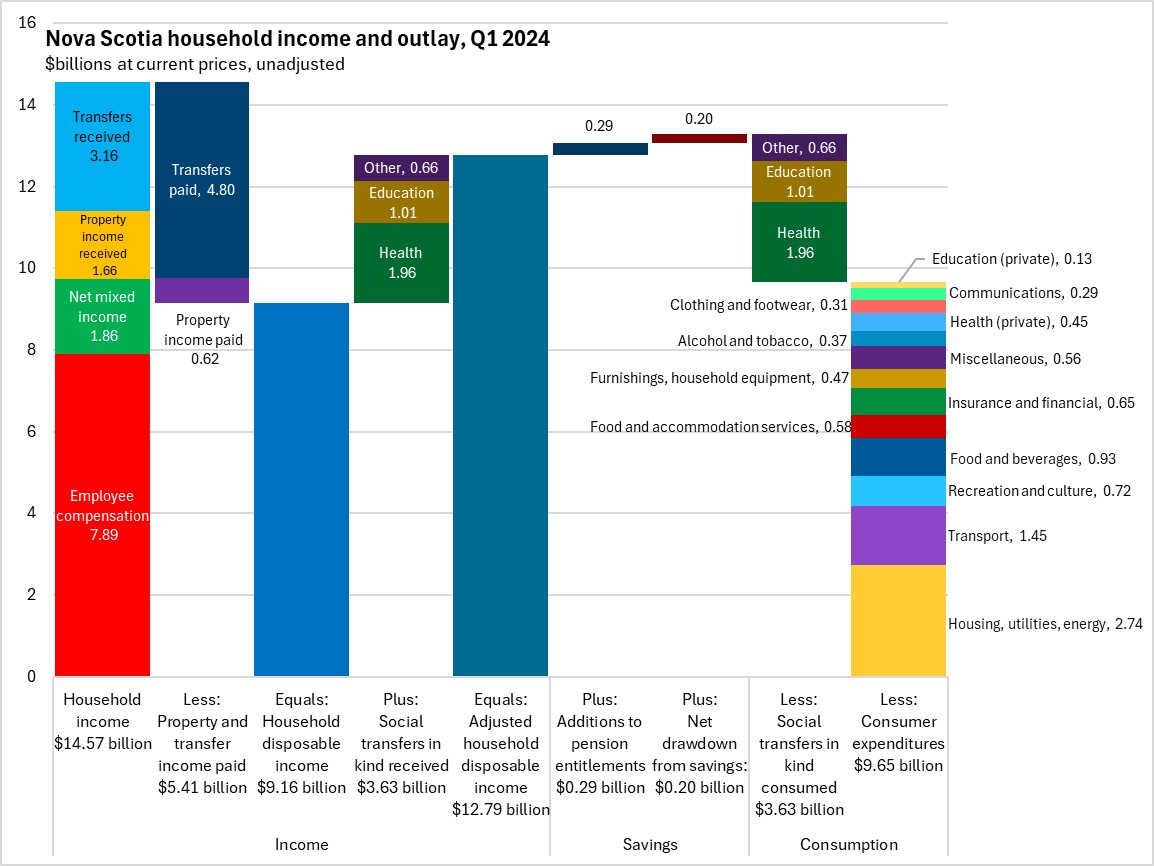
Household income
Nova Scotia's overall household income growth from Q1 2023 to Q1 2024 was 10.5% - the fastest increase among provinces. All provinces reported rising household income year-over-year, with the slowest gain in Saskatchewan. National household income increased by 8.0% from Q1 2023 to Q1 2024.
Nova Scotia's rising household income reflected employee compensation growth of 9.5%, also the fastest increase among provinces. Nationally, employee compensation was up 6.1% year-over-year with gains in all provinces (weakest growth in Saskatchewan)
Nova Scotia's net mixed income from unincorporated businesses grew 15.3% from Q1 2023 to Q1 2024, the third fastest growth among provinces. National net mixed income was up 13.1%. Saskatchewan reported the fastest growth from Q1 2023 to Q1 2024 while Ontario and Québec reported the slowest increases (though both were just under 12%)
Despite a strong gain of 17.1% from Q1 2023 to Q1 2024, Nova Scotia's growth in property income receipts lagged all other provinces except Saskatchewan and Alberta. The national average gain in property income received was 18.2% with the fastest growth in Manitoba.
Current transfers received were up 7.3% in Nova Scotia from Q1 2023 to Q1 2024, the fastest rise among provinces. The national pace of transfer growth was 5.1%. All provinces reported higher transfers, with Saskatchewan reporting the slowest rise.
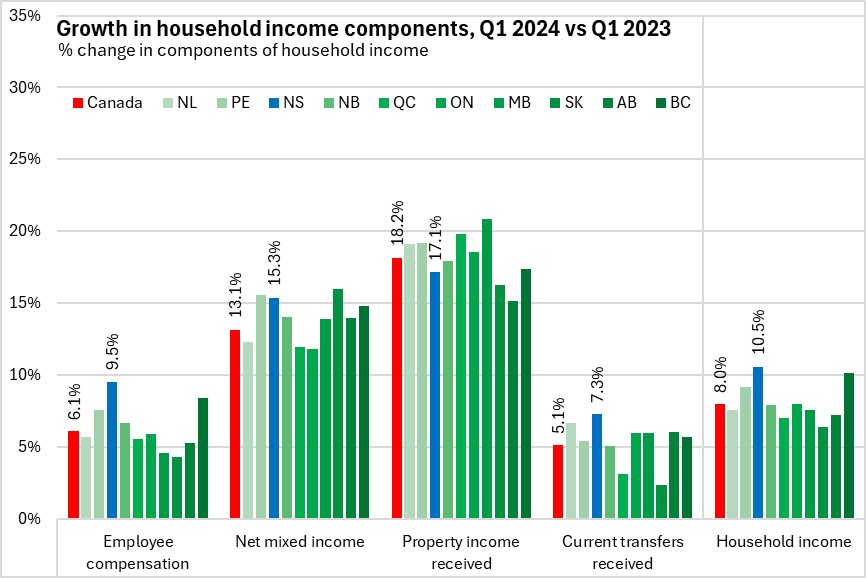
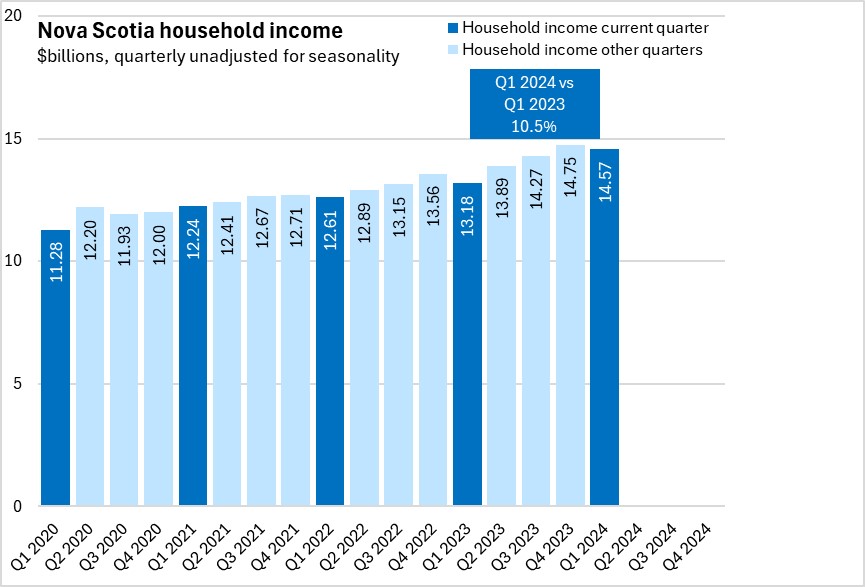
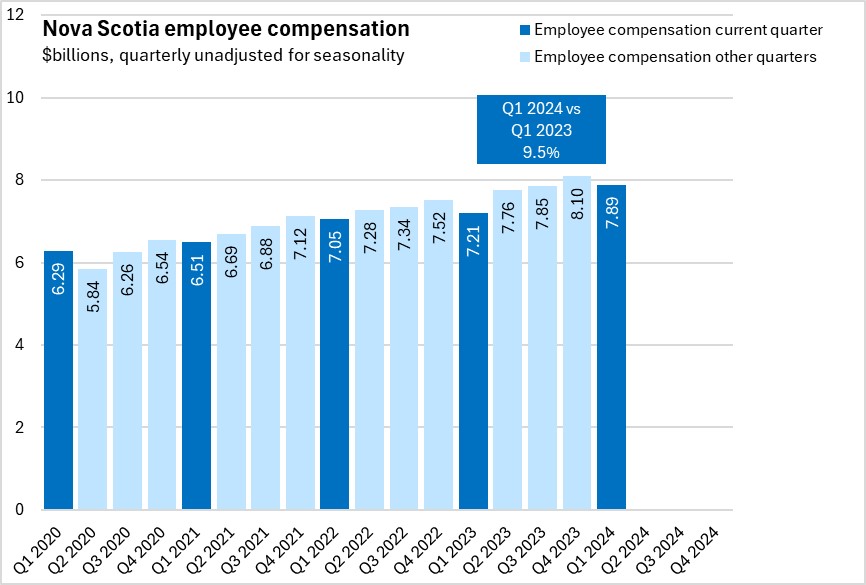
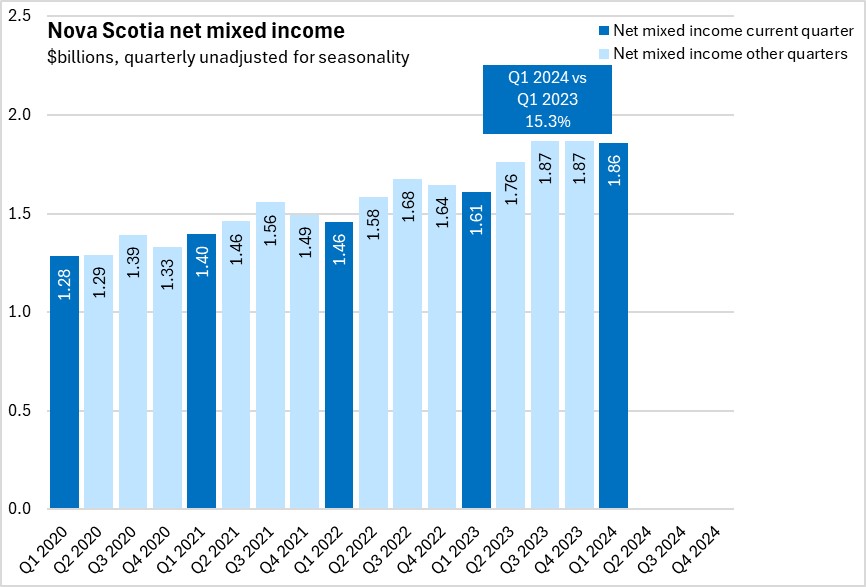
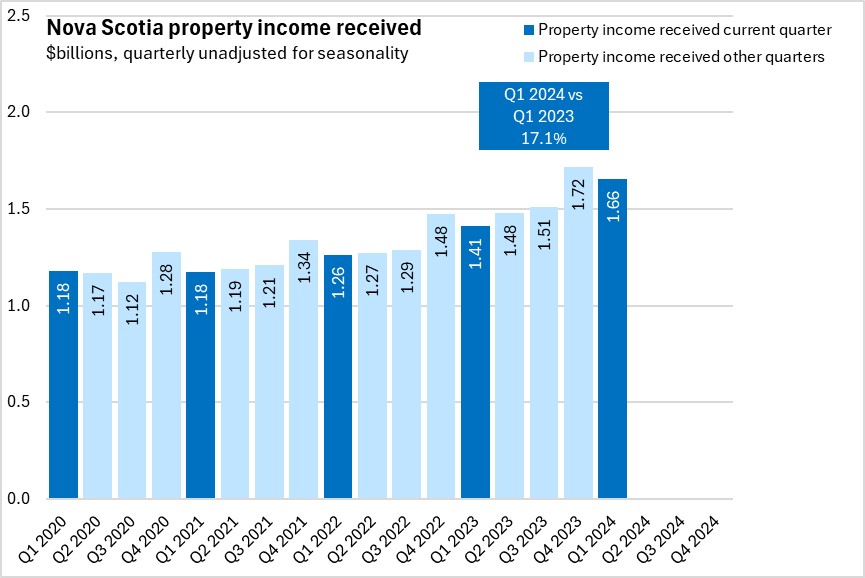
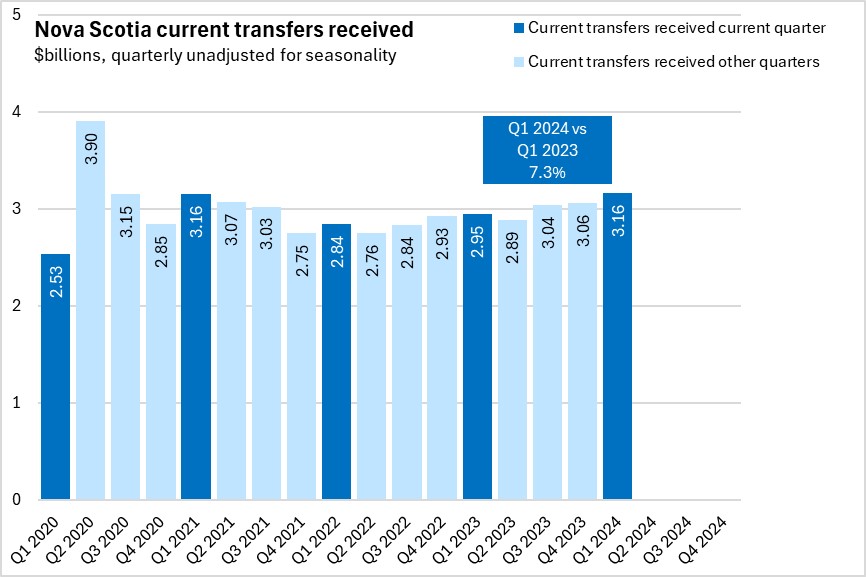
In Q1 2024, Nova Scotia's household income was $30,022 per household or 79.2% of the national average ($37,917). The highest income per household was in Alberta and lowest in Prince Edward Island.
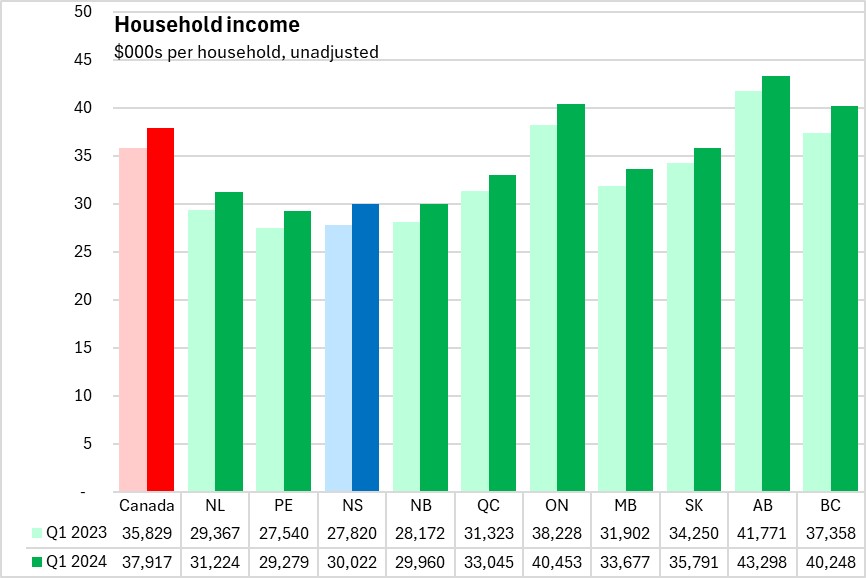
Nova Scotia's employee compensation $16,265 per household, amounting to 72.7% of the national average per household ($22,370). Alberta reported the highest employee compensation per household and Prince Edward Island the lowest.
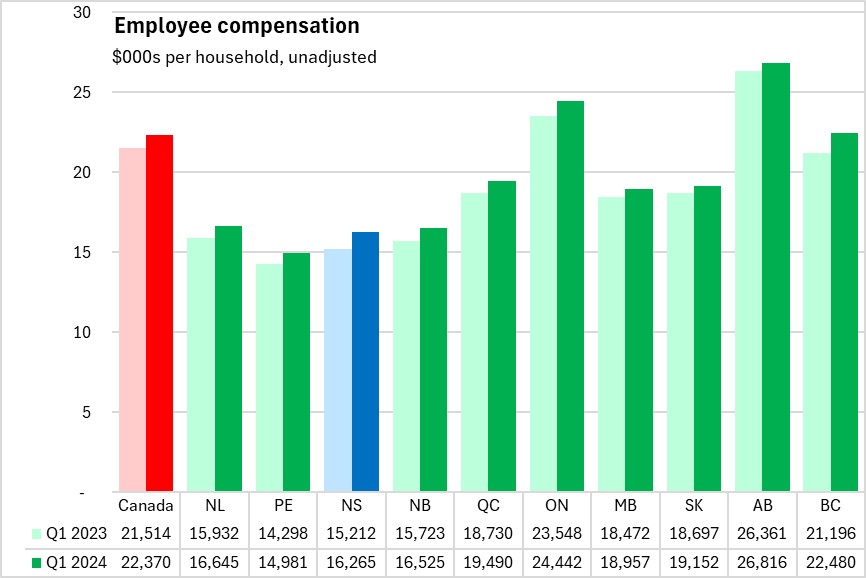
Nova Scotia's net mixed income generated by unincorporated businesses amounted to $3,829 per household, which was 99.4% of the national average per household of $3,854. Across Canada, the highest value of net mixed income per household was in British Columbia and the lowest was in Québec.
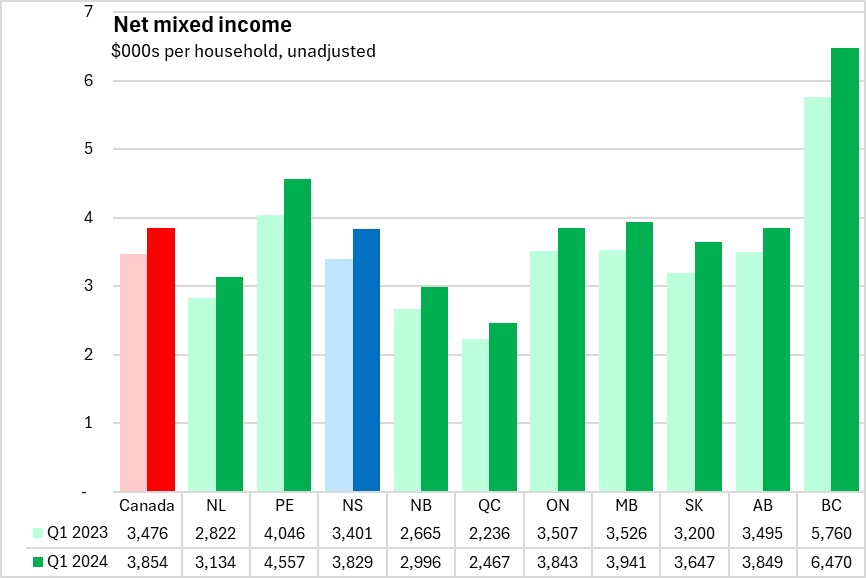
Nova Scotia property income received in Q1 2024 was $3,411 per household, which was 71.4% of the national average ($4,774 per household). The highest property income values were in British Columbia, Alberta, and Ontario. The lowest property income per household was in Newfoundland and Labrador.
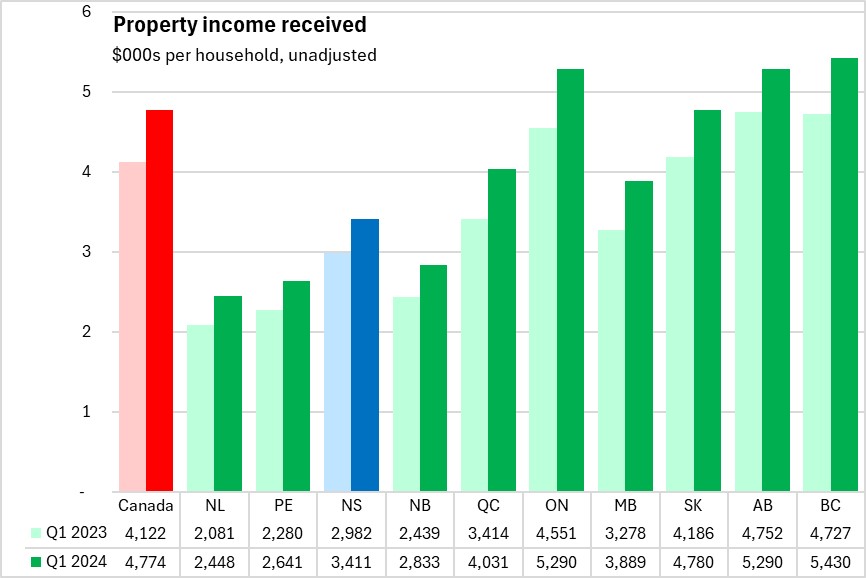
Current transfers received in Nova Scotia were $6,517 per household in Q4 2023. Current transfers received in Nova Scotia were 94.2% of the national average per household ($6,919). Transfers per household were highest in Newfoundland and Labrador and lowest in British Columbia.
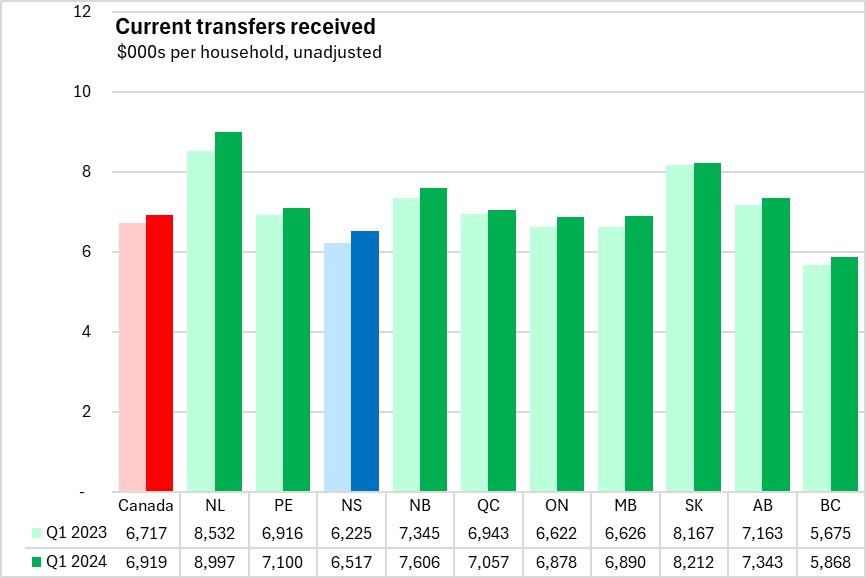
Household Consumer Expenditures
Comparing Q1 2024 with Q1 2023, Nova Scotia's household consumer expenditures increased by 4.9%, just below the national pace. Year-over-year growth in consumer expenditures was mostly uniform across the country, ranging from a low of 4.7% in Québec to a high of 5.3% in British Columbia.
Social transfers in kind refer to services that are provided for the benefit of households but are paid for by governments and non-profits. These are primarily health and education expenditures, which add to private expenditures made on these services. Social transfers in kind increased by 2.5% in Nova Scotia (5.5% nationally) from Q1 2023 to Q1 2024. Social transfers in kind grew fastest in Alberta and British Columbia. Ontario reported the only decline for social transfers in kind.
The sum of household final consumer expenditures and social transfers in kind is termed 'household actual final consumption expenditures', which reflects the benefits to households from both private expenditures as well as services provided by governmens and non-profits. Combining these two components led to household actual final consumption growth of 4.2% for Nova Scotia, which was slower than the national growth of 5.1%. Alberta and British Columbia reported the fastest growth in actual final consumption while Ontario reported the slowest growth.
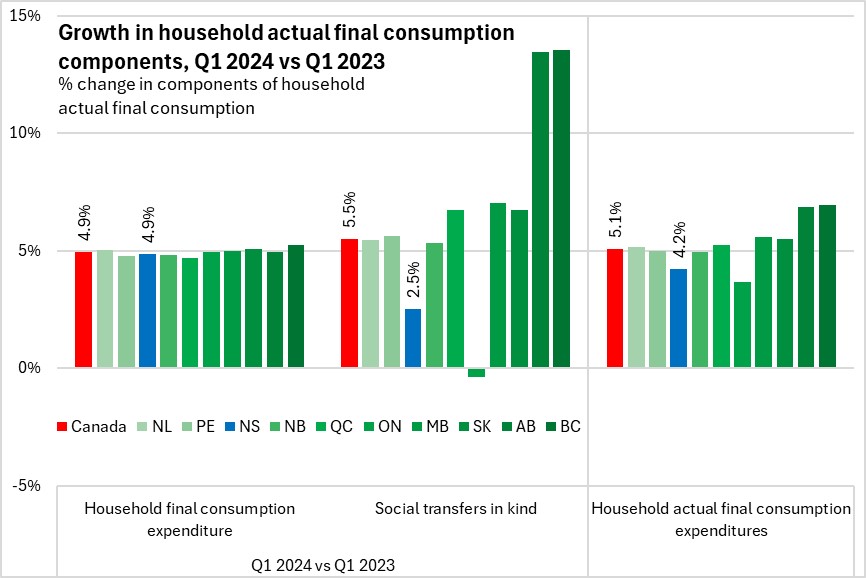
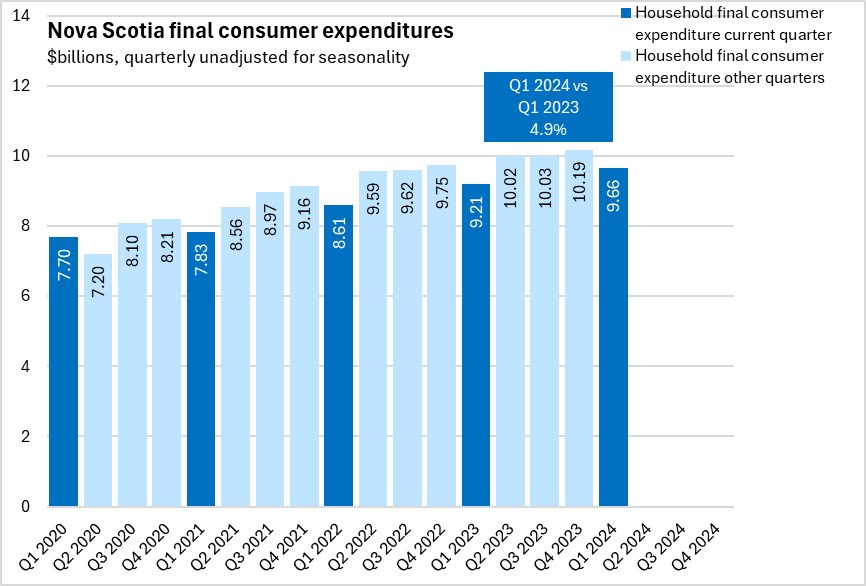
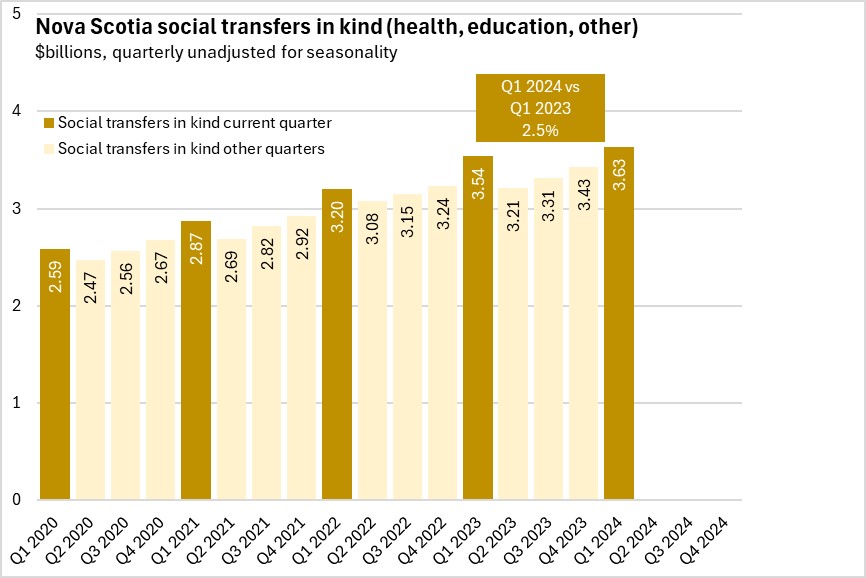
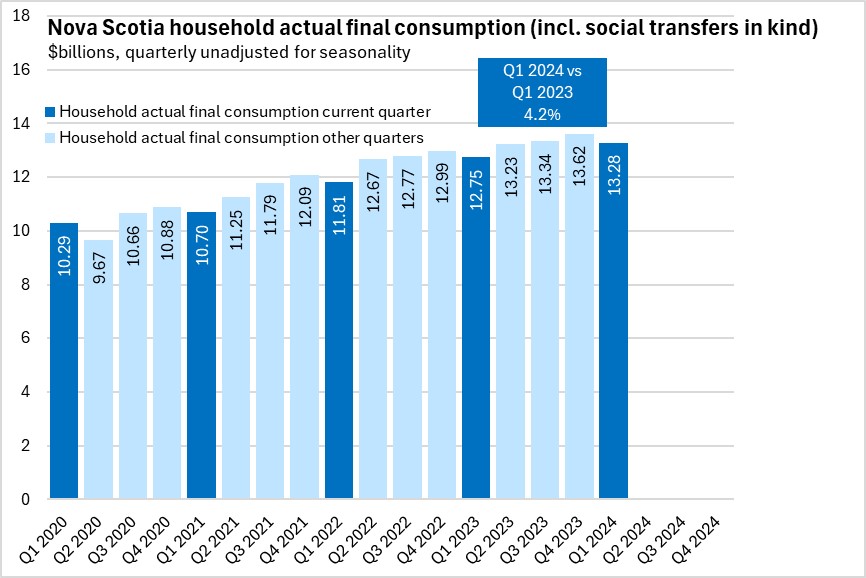
Among the categories of actual final consumption expenditures, housing/utilities/energy made up the largest category of household consumer expenditures, followed by social transfers in kind for health care, transportation, social transfers in kind for education, food/beverages and recreation/culture.
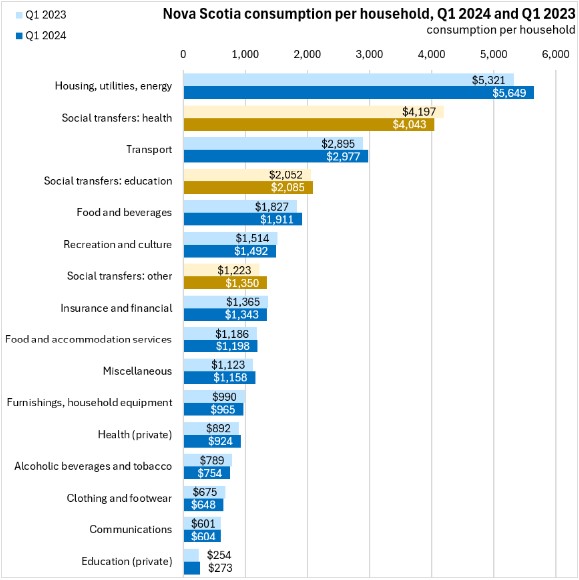
From Q1 2023 to Q1 2024, growth in per household spending was fastest in social transfers for non-health/education purposes, followed by private education services, housing/utilities/energy and food/beverages. Expenditures were down for alcoholic beverages/tobacco, clothing/footwear, health social transfers, household furnishings/equipment, insurance/financial services and recreation/culture.
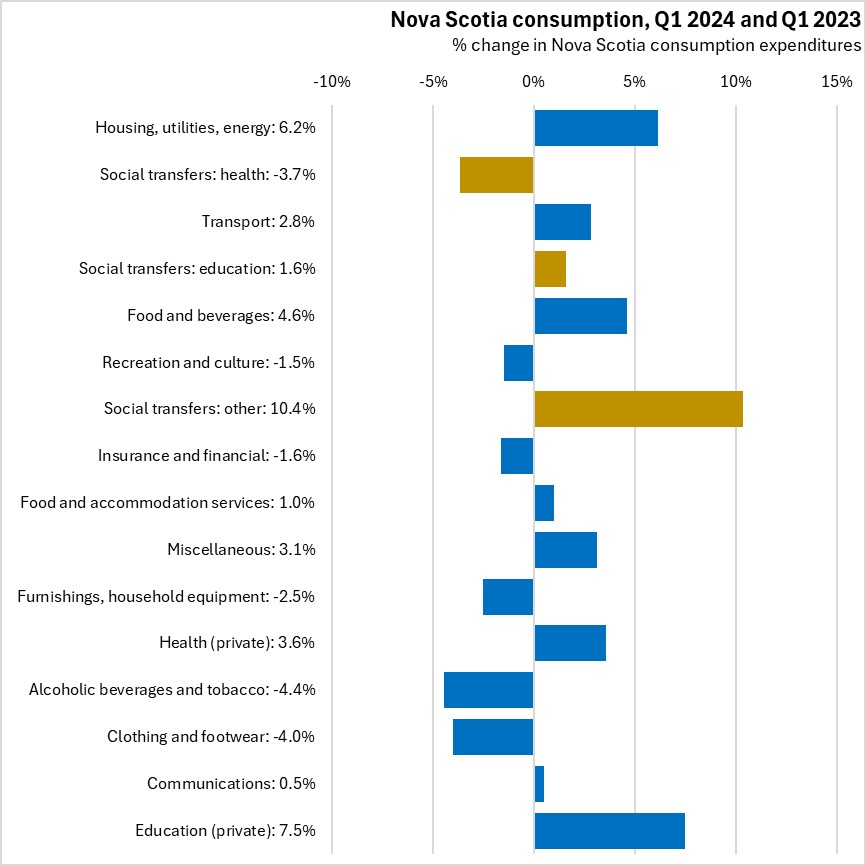
Nova Scotia's final consumer expenditures (paid for private by households) amounted $19,895 per household (88.0% of the national average per household). Across Canada, final consumer expenditures per household were $22,601 with the highest values in British Columbia and Alberta and the lowest value in Québec.
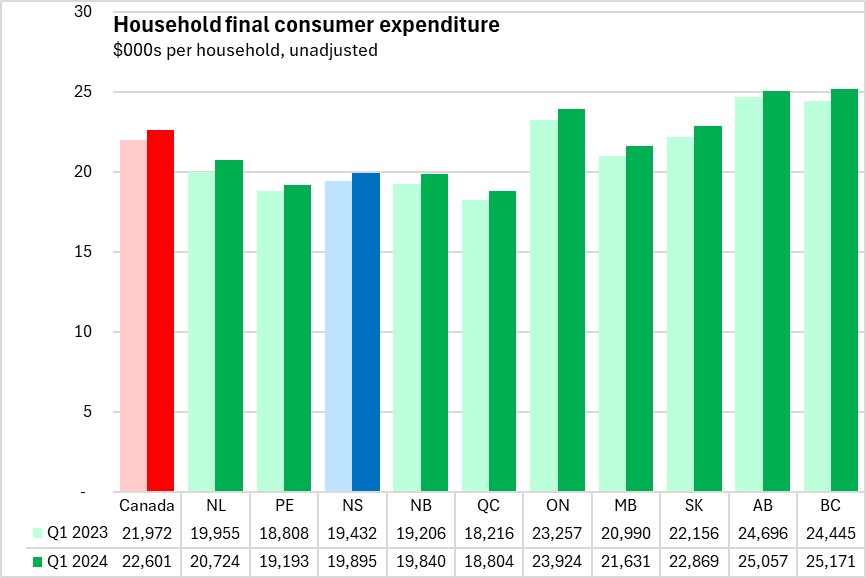
In Q1 2024, Nova Scotian households received $7,478 per household worth of social transfers in kind (104.0% of the national average per household). Across Canada, social transfers in kind were $7,189 per household with the highest value in Manitoba and the lowest value in Prince Edward Island.
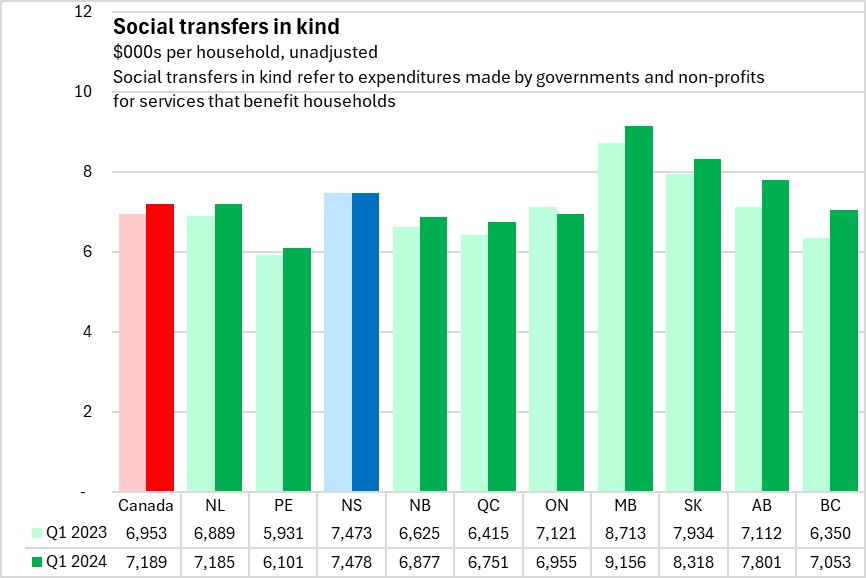
Nova Scotia's household actual final consumption expenditures in Q1 2024 were $27,373 per household (91.9% of the national average per household). National household actual final consumption expenditures were $29,790 per household with the highest value in Alberta and the lowest values in Prince Edward Island and Québec.
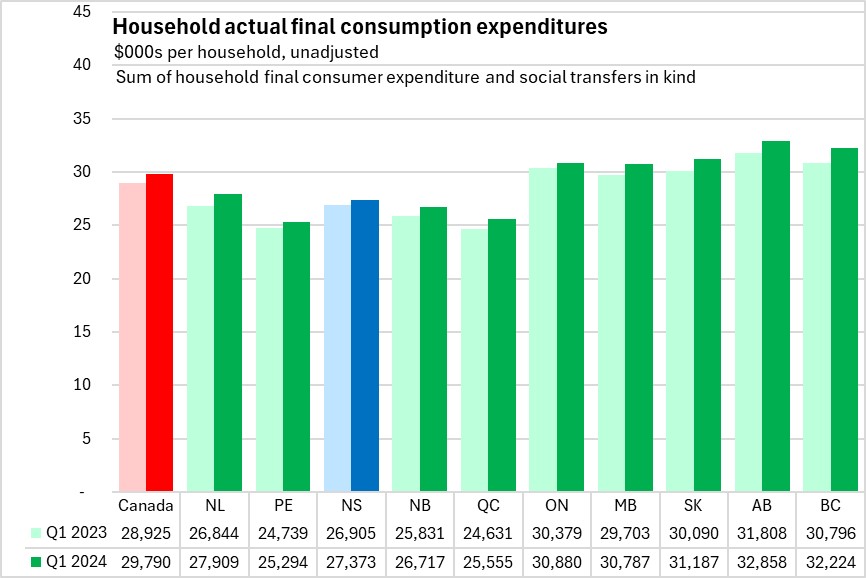
In Q1 2024, Nova Scotia's net savings per household were -$421. Newfoundland and Labrador, Nova Scotia, New Brunswick and Saskatchewan reported negative net savings in Q1 2024. National savings were a positive $1,660 per household with the highest value in Alberta.
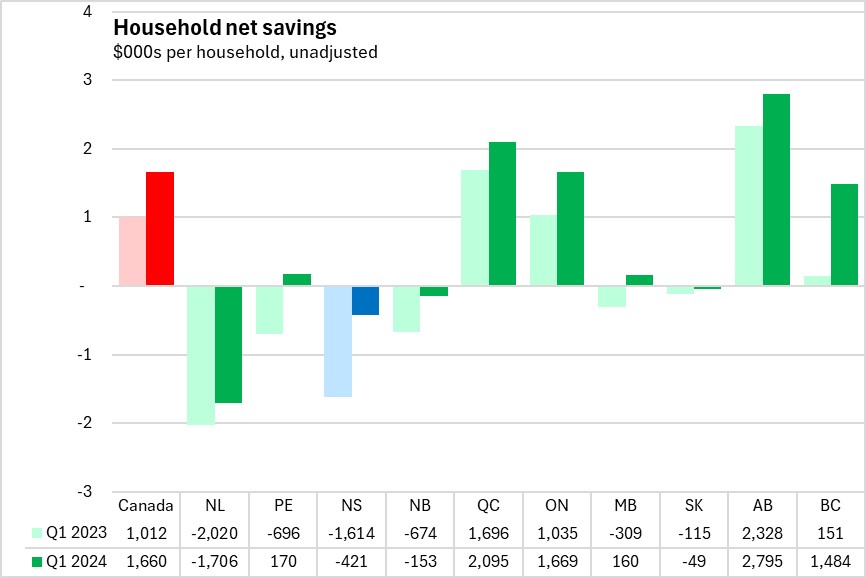
Source: Statistics Canada. Table 36-10-0663-01 Distributions of household economic accounts, income, consumption and saving, Canada, provinces and territories, quarterly (x 1,000,000)
<--- Return to Archive